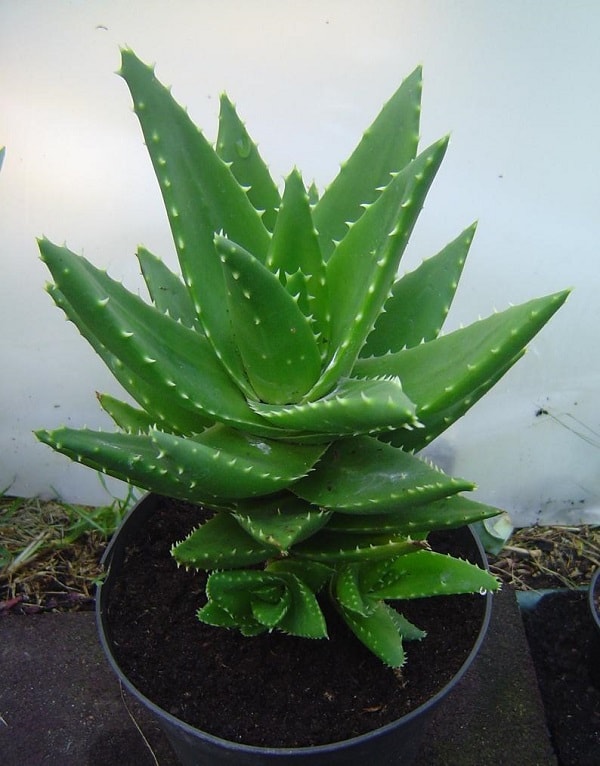With in the family of the Xanthorrhoeaceae (subfamily Asphodeloideae), the genus Aloe is classified, composed of about 500 species of succulent plants from Africa, Madagascar, and the Middle East.
It is known by the vulgar names of Dwarf Aloe or Aloe Juvena.
This species is native to Kenya.
This species is native to the African continent but its easy cultivation and beauty have caused its distribution to have expanded to numerous collections around the world.
These are small aloes that branch off at the base forming rosettes of spirally arranged leaves on the stem that can reach about 20-25 cm in height.
These leaves have a triangular shape, the edge with small white teeth and are light green with white spots; if they receive a lot of sun they adopt reddish and brown tones.
They produce tubular flowers, orange or pink and yellow, in floral stems above the leaves. They can bloom at different times of the year.
The Aloe Juvenna species is frequently confused with Aloe squarrosa because of its great resemblance; Some authors consider these two species as synonyms.
This species is characterized by forming spiral rosettes of fleshy leaves that grow very compact.
In general, the growth in the first months of life is unidirectional but with time, the plant will generate new shoots on its sides that will form very compact small shrubs.
They have observed specimens that have reached more than 60 cm long.
Rosette growth is vertical in young plants but when they are very large (in length), they tend to rest on the ground (horizontal growth) because of the weight of the plant.
The Aloe Juvenna leaves are fleshy, lanceolate-triangular and quite small (+/- 6 cm long).
They have dark green coloration (lighter in dimly lit areas and brown if they are exposed to the sun) with numerous white spots (darken with the intense sun) on the beam and underside arranged irregularly.
The edges of the leaves have numerous whitish spines of soft consistency.
These spines have their apex somewhat convex and not sharp.
All these spines are generally directed towards the center of the leaf and the leaves fold a little along their central axis.
The flowers appear on the sides of the leaves closest to the apex of the rosette.
These are arranged in long clustered inflorescences where the floral stem can reach more than 20 cm long.
The flowers are tubular-cylindrical with the orange-red corolla and its light green apices.
The flowers appear on the sides of the leaves closest to the apex of the rosette.
These are arranged in long clustered inflorescences where the floral stem can reach more than 20 cm long.
The flowers are tubular-cylindrical with the orange-red corolla and its light green apices.
Tips to take care of the Aloe Juvenna
Juvenile aloe is very easy to maintain in the garden and has been listed as a beginner plant.
Your requirements are minimal; We leave them below:
Illumination:
It is necessary to expose it directly to the sun so that its growth is benefited.
Under these conditions, the plant takes brown tones. Its semi-shade cultivation does not cause serious damage to your health (it grows slower and may not bloom) and your aesthetic is benefited (it maintains the white chlorination of the spots and the green of the leaves).
Temperatures:
It grows best in hot climates with weak winters.
Ideal temperatures should range between 20-35 ° C and remain fairly stable throughout the day. Temperatures below 5 ° C are fatal.
Substratum:
Ideal for substrates based on sand, little soil and many rocks.
The substrate must have perfect drainage to prevent roots from rotting.
Watering:
“Tiger Tooth Aloe” has typical watering needs for a succulent.
It’s best to use the “soak and dry” method, and allow the soil to dry out completely between watering.
Water only when the substrate is very dry (check with your fingers or by inserting a thin wooden stick).
Watering should be deep until the water flows through the drainage holes of the pot. In winter, watering should be reduced to avoid possible rot.
Plagues and diseases:
The most common pests are aphids and mealybugs. They take advantage of the dry leaf shelter to feed on the stem without being disturbed.
It is recommended to remove all the dry structures of the plant to eliminate hiding places for pests.
They are also housed in the tender leaves but their easy detection allows us to act quickly.
The most frequent pathology in this plant is root rot due to excessive irrigation.
Propagation:
It is done easily by cuttings of young plants that appear on the stem.
We must use sharp and disinfected utensils to avoid parasitic infections due to contamination of the tools.
Cut cuttings should be sown (sandy substrate with slightly damp rock mulch) when the cutting area is dry.
They usually take root at 2-3 weeks.
Conclusion
The Aloe Juvenna It is a beautiful plant easy to care.
If your thinking of buying one or growing it I’m sure you will enjoy this plant.
And its a great give for plant lover.
Plus it will connect your home with nature.
Hope this article was helpful.
If you have any question please let me know.
